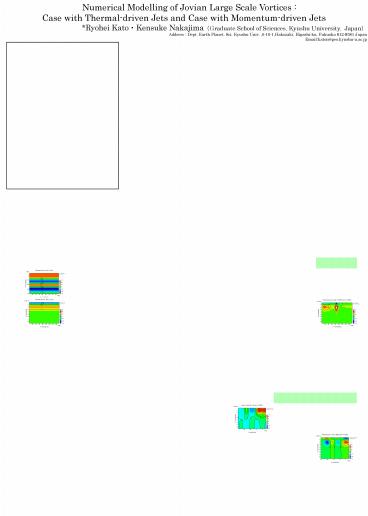Numerical Modelling of Jovian Large Scale Vortices : - PowerPoint PPT Presentation
1 / 1
Title:
Numerical Modelling of Jovian Large Scale Vortices :
Description:
Numerical Modelling of Jovian Large Scale Vortices : ... The coherent vortex has a cold core at the top and a warm core below (fig.14) ... – PowerPoint PPT presentation
Number of Views:64
Avg rating:3.0/5.0
Title: Numerical Modelling of Jovian Large Scale Vortices :
1
Numerical Modelling of Jovian Large Scale
Vortices Case with Thermal-driven Jets and Case
with Momentum-driven Jets Ryohei KatoKensuke
Nakajima(Graduate School of Sciences, Kyushu
University, Japan) Address Dept. Earth Planet.
Sci, Kyushu Univ. ,6-10-1,Hakozaki, Higashi-ku,
Fukuoka 812-8581 Japan Emailkaton_at_geo.kyushu-u.ac
.jp
1.Introduction
2.Model and Setup
- Computational domain and resolution
- zonal 0 180, NX100, ??1.8
- meridional 0 - 40, NY40 , ?F1.0
- vertical H 10000km , NZ20, ?z ?exp(5z/H)
- Timestep 1/50(day),integral time 6000(day)
One of the major issues on the dynamics of
Jupiters atmosphere is the vertical structure of
thermal stratification and zonal wind. It has
been suggested that the vertical structure can be
inferred
Basic equations
Momentum forcing
by comparing the behavior of large-scale
vortices, such as the Great Red Spot(GRS), with
those in numerical experiments with various basic
states assumed (Williams,1996). Another major
issue is the mechanism of the maintenance of
strong zonal jets. There are mainly two streams
of argument has been proposed. One is the
eddy-momentum driving theory (Ingersol,2000) and
the other one is the thermal driving theory
(Williams,2002) . Both of two issues above,
which are presumably interrelated, remains
unsolved even after the direct entry of Galileo
probe into the Jupiters atmosphere. The recent
reddening of White Oval BA may provide us some
additional hints (Simon-Miller et al.,2006).
We are performing a series of numerical
experiments on large-scale vortices using a
three-dimensional model which is based on the
primitive equation of Boussinesq fluid. We focus
on the possible sensitivity of the behavior of
simulated vortices to the forcing mechanism of
zonal jets. We compare the development and
maintenance of vortices with different types of
forcing and different relaxation times.
Thermal forcing
Setup of Experiments Experiments are performed
with the following combinations of forcing terms.
Parameters
- Boundary condition
- Zonal cyclic
- Meridional symmetric, no-flux(EQ)
- no-slip, no-flux(South Boundary)
- Vertical free-slip, no-flux
3. Results
In all experiments, vortices are initially
generated along about 22S, but aspects of the
later time evolution diverge as shown below.
Structure of eddies
Exp.NF small scale instability waves gradually
merge to a coherent vortex resembling the Great
Red Spot. However, the amplitude of temperature
disturbance gradually decay (fig.1,2).
Exp.M30 small vortices merge to a large vortex,
but the large vortex is not coherently
maintained, interacting with newly formed small
eddies (fig.3). Exp.M1000 a coherent vortex
emerges(fig.5). The temperature anomaly is
positive at all altitudes (fig.6).
Exp.T30 small scale vortices are continuously
generated throughout the experiment, and they
dont evolve into a coherent large
vortex(fig.7,8). Exp.T1000 two coherent
vortices are established (fig.9). They have cold
cores at the top and warm cores below (fig.10).
Exp. B30 small scale vortices continuously
generated and merge into large vortices, which
are not coherently maintained (fig.11,12).
Exp.B1000 a coherent vortex is established. It
eats weaker vorticity anomalies that emerge
continuously (fig.13). The coherent vortex has a
cold core at the top and a warm core below
(fig.14).
NF
M30
B1000
B30
T1000
T30
M1000
Initial
11
7
5
3
9
1
13
T( z -200km)
2
12
8
6
4
10
14
T( 22S)
Zonally Averaged Structure
Exp.NF the easterly jet at 16S and the
westerly jet at 26S become weak and vertical
structure of the easterly jet changes from
baroclinic to equivalent barotropic(fig.15).
Vertical structure of temperature disturbance
associated with the easterly jet(from 10S to
25S ) departs significantly from initial
profile(fig.16).
Exp.M30 and Exp.M1000 the westerly jet is
maintained, but the easterly jet become weak
and its core of maximum wind speed
significantly shifts above even in case with
short relaxation time (30day) (fig.17,19).
Vertical structure of temperature disturbance
associated with the easterly jet is also
changed(fig.18,20).
Exp.T30 and Exp. T1000 the latitudinal structure
of the equatorial westerly jet changes two
velocity cores appear at off-equatorial
latitude(fig.21,23). In deep region, barotropic
jets are generated(fig.21). Temperature
disturbance amplitude and vertical structure is
maintained in case T30(fig.22), but amplitude
associated with the easterly jet become weak in
case T1000(fig.24)
Exp.B30 wind speed of the jets and the
temperature disturbance amplitude are almost
maintained (fig.25). Exp.B1000 the easterly jet
and the temperature disturbance amplitude become
weak(fig.27)
NF
M30
B1000
B30
T1000
T30
M1000
Initial
25
21
19
17
23
15
27
U(y,z)
16
26
22
20
18
24
28
T(y,z)
5. Future works
4. Summary
- Budget analysis of momentum equation is needed
to understand the change of easterly jets wind
speed and vertical structure even in the case
with strong momentum forcing. - To investigate the generation mechanism of
initial vortices is needed. - In this experiment, we use the forcing that damp
the zonal mean variables to the initial structure
. We need to examine sensitivities to other type
of forcing, for example, momentum forcing which
is acts only in the shallow weather layer.
- Due to different types of forcing mechanisms and
relaxation times, formation of vorticies may be
different. - To maintain the structure of jets as those of the
initial condition, both of momentum and thermal
forcing are necessary.































